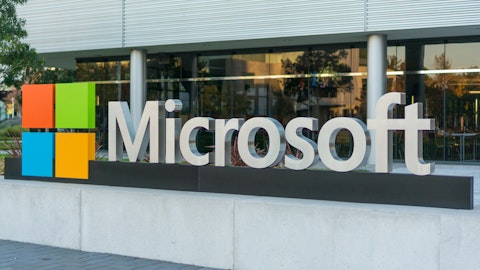FedEx Corporation (NYSE:FDX) Q1 2024 Earnings Call Transcript September 20, 2023
FedEx Corporation beats earnings expectations. Reported EPS is $4.55, expectations were $3.73.
Operator: Good day and welcome to the FedEx Fiscal Year 2024 First Quarter Earnings Call. All participants will be in a listen-only mode. [Operator Instructions] After today’s presentation, there will be an opportunity to ask questions. [Operator Instructions] Please note this event is being recorded. I would now like to turn the conference over to Mr. Mickey Foster, Vice President of Investor Relations. Please go ahead, sir.
Mickey Foster: Good afternoon and welcome to FedEx Corporation’s First Quarter Earnings Conference Call. The first quarter earnings release, Form 10-Q and stat book are on our website at fedex.com. This call and the accompanying slides are being streamed from our website, where the replay and slides will be available for about one year. Joining us on the call today are members of the media. During our question-and-answer session, callers will be limited to one question in order to allow us to accommodate all those who would like to participate. Certain statements in this conference call such as projections regarding future performance may be considered forward-looking statements. Such forward-looking statements are subject to risks, uncertainties and other factors which could cause actual results to differ materially from those expressed or implied by such forward-looking statements.

A driver unloading packages from a van for a time-critical delivery. Editorial photo for a financial news article. 8k. –ar 16:9
For additional information on these factors, please refer to our press releases and filings with the SEC. Please refer to the Investor Relations portion of our website at fedex.com for a reconciliation of the non-GAAP financial measures discussed on this call to the most directly comparable GAAP measures. Joining us on the call today are Raj Subramaniam, President and CEO; Brie Carere, Executive Vice President, Chief Customer Officer; and John Dietrich, Executive Vice President and CFO. Before I turn the call over to Raj, I wanted to let everyone know that I’m retiring from FedEx at the end of October. It has been a privilege being a long-time part of the FedEx team. I truly believe that FedEx’s best days are ahead, but I will be cheering from the sidelines as I am 67 years old, and I want to spend more time with my family.
With that I will now turn it over to Raj for him to share his views on the quarter.
Raj Subramaniam: Thank you, Mickey, and good afternoon. I would like to first congratulate Mickey on his upcoming retirement. He has led our Investor Relations team for nearly 18 years, spanning 70 earnings calls, and after tomorrow, 18 annual meetings. He will be missed by all and especially this audience, and we thank him for his outstanding service to FedEx over the years. Let me also take this opportunity to welcome John Dietrich, our Chief Financial Officer for FedEx. With more than 30 years of experience in the aviation and air cargo industries, John brings a unique blend of financial and operational expertise to our leadership team at a very important time for this company. He’s already hit the ground running and I’m very happy that he has joined FedEx. So now turning to the quarter.
We entered fiscal year ’24 with strength and momentum, delivering results ahead of expectations in what remains a dynamic environment. I’m proud of what the FedEx team has accomplished over the last 12 months. Amid significant demand disruption, we delivered on what we said we would do, driving over $2 billion in year-over-year cost savings in fiscal ’23. We are now well advanced in executing on that transformation to be the most efficient, flexible and intelligent global network. Our first quarter progress gives me great conviction in our ability to execute going forward. We came into the quarter determined to provide excellent service to our customers despite the industry dynamics. We achieved that goal while delivering innovative and data-driven solutions that further enhance the customer experience.
As a result, we are well positioned as we prepare for the peak season. As you can see in our results on slide six, our transformation is enhancing our profitability. Ground was a bright spot with higher revenue year-over-year driven by higher yield. On top of this growth, Ground drove exceptional operational performance, leading to its most profitable quarter ever on an adjusted basis. As expected, total revenue declined as volumes and yields were pressured at Express and Freight. We indicated last quarter that Express revenue would be adversely impacted by international export yield pressure as well as a change in strategy by the US Postal Service, which we are addressing through DRIVE as we build a more nimble airline. For the total company, we delivered 200 basis points of adjusted margin improvement as we realize efficiencies across our networks.
This performance is a testament to the power of DRIVE and the FedEx team working collaboratively to implement structural cost reductions throughout the enterprise. During the quarter, labor negotiations at our primary competitor and the bankruptcy of Yellow disrupted the market. Our priorities were clear. Protect our customers, deliver outstanding service and focus on high-quality revenue. We delivered on those priorities, leveraging our flexible network to profitably add volume while maintaining the highest levels of service. While we capture upside as a result of these onetime events, we were highly discerning in terms of the business we accepted in keeping with our goal to drive high-quality revenue. Importantly, we expect to maintain the majority of the volume we added in the quarter.
I want to thank our FedEx team for deftly navigating these conditions to execute on our disciplined strategy. Now turning to DRIVE. We are fundamentally changing the way we work. DRIVE is taking cost out of our network and we are on track to deliver our targeted $1.8 billion in structural benefits from DRIVE this fiscal year. At Ground, our DRIVE initiatives reduced costs by $130 million this quarter. These savings were primarily driven by lower third-party transportation rates as a result of a newly implemented purchase bid system as well as optimized rail usage, the continued benefit from reduced Sunday coverage and the consolidation of sorts. At Freight, we continue to manage our cost base more effectively. For example, during the quarter, Freight completed the planned closure of 29 terminal locations during August.
And at Express, despite headwinds from Asia yields and the US Postal Service, we delivered on our plan. We’re making our global network more efficient primarily through structural flight takedowns and efficiencies at our hubs and sorts as we right-size the capacity across the network. In Europe, DRIVE initiatives are on track and we expect them to gain further traction over the course of the year and into FY’25. Looking ahead, we are excited to leverage John’s aviation experience as we continue to transform our air network. And our DRIVE expectations for this year include the G&A savings we have previously outlined, which we believe will start to ramp in the second half of this fiscal year. Finally, on slide eight, I will provide a brief update on our key strategic focus areas as we move into the next phase of our transformation.
This includes One FedEx, which is how we are better aligning our organization to enable Network 2.0. We are well underway with plans to simplify our organization. In June 2024, FedEx Express, FedEx Ground and FedEx Services will consolidate into one company, Federal Express Corporation. The reorganization will reduce and optimize overhead, streamline our go-to-market capabilities and improve the customer experience. To-date, we have implemented or announced Network 2.0 in several markets, including Alaska, Hawaii and Canada. As each market is different, we’re continuously learning and tailoring the network to adapt to the operational characteristics unique to each region while delivering the highest quality service for our customers. We’ll continue to use both employee couriers and service providers for pickup and delivery operations across the network.
As with any significant transformation, these changes are being thoughtfully executed and will take time to complete. The network that FedEx has built over the last 50 years provides us a foundation that is unmatched. This physical network enables us to transport millions of packages a day around the world, generating terabytes of data that contain invaluable insights about the global supply chain. We are focused on harnessing the power of this rich data to make supply chains smarter for everyone, for our customers, for our customers’ customers and for ourselves. As we move to the next phase of our transformation, I have given the team three specific challenges, to use data to make our network more efficient, make our customer experiences better and drive new profitable revenue streams through digital.
Looking ahead to the rest of FY’24, we remain focused on delivering the highest-quality service and aggressively managing what is within our control. Factoring in better-than-expected first quarter results, we are increasing the midpoint of our adjusted EPS outlook range. As we continue to deliver on our commitments, I’m confident we have the right strategy and the right team in place to create significant value. With that let me turn the call over to Brie.
Brie Carere: Thank you, Raj, and good afternoon, everyone. In the first quarter, we remained focused on revenue quality and being a valued partner to our customers. We did this in an operating environment marked by continued, but moderating volume pressure, mixed deal dynamics and unique developments in the competitive landscape. Let’s take each segment in turn. At FedEx Ground, first quarter revenue was up 3% year-over-year, driven by a 1% increase in volume and 3% increase in yield. Revenue at FedEx Express was down 9% year-over-year. Volume remained pressured though total Express volume declines moderated sequentially. International export package volumes were up 3% year-over-year. Similar to the fourth quarter, parcel volume declines were most pronounced in the United States.
Additionally, US freight pounds were down 27%, continuing the trend we mentioned last quarter tied to the change in strategy by the United States Postal Service. Across Ground and Express, volumes improved sequentially, aided by the threat of a strike at our primary competitor. We onboarded new customers who valued our service and were committed to a long-term partnership with FedEx. As a result, we added approximately 400,000 in average daily volume by the end of the first quarter and the team did an excellent job focusing on commercial Ground business acquisition. At FedEx Freight, revenue was down 16%, driven by a 13% decline in volume. We experienced significant improvement in volume in August due to Yellow’s closure. Freight benefited from approximately 5,000 incremental average daily shipments at attractive rates as we exited the quarter.
As you can see on slide 11, monthly volumes have improved sequentially, with Ground and international export volumes inflecting positively on a year-over-year basis. We expect to continue benefiting from this quarter’s market share gains throughout the fiscal year. We anticipate improved year-over-year growth rate, especially late in the fiscal year, albeit within a muted demand environment. The yield trends we shared last quarter persisted, particularly at FedEx Express, where we saw reduced fuel and demand surcharges year-over-year. Product mix shifts, including an increase in e-commerce volume and demand for our International Economy service after the May reopening in EMEA also put pressure on yield growth. At FedEx Ground, we saw better-than-expected yields as a result of higher weight per package and product mix.
At FedEx Freight, base rates were strong despite lower weights. The revenue per shipment year-over-year decline was due to lower fuel surcharges. Now looking ahead to peak, we recently announced demand surcharges for the holiday shipping season to stay well positioned relative to market. We also announced a 5.9% general rate increase effective this coming January. This average annual increase, one point below last year’s rate, reflects the current cost and market environment along with the investment we need to serve customers effectively. We had a high capture rate for our GRI in FY’23 and believe this year’s increase will ensure that continues. We continue to find new revenue quality opportunities. In 2024, we will implement technology changes to increase our capture of packaged dimensions in several markets outside of the United States.
Further, we are updating our dimensional pricing to market practice in Europe, moving from per shipment to a per piece strategy. Moving to slide 13, I was very pleased with our service levels around the world. I’m proud of how our team delivered here in the United States as we added volume late in the quarter. We are also building momentum in Europe. We improved service year-over-year in the region. And as a result, the Europe team was able to win back market share that we lost due to previous service challenges. There’s still work to do, but our service improvements are also leading to better financial performance in Europe with much more to come. As Raj stated, we have a vision to make supply chains smarter for everyone, and I have a few examples of how our digital infrastructure is enabling new capabilities for our customers.
We are improving the customer experience through technology with recent investment in Salesforce Data Cloud. We will integrate three customer platforms. Customer service, marketing and sales into one, giving the customer a more informed, efficient and personalized experience when doing business with FedEx. We are now offering our estimated delivery time window, which provides customers with a four-hour window for their package delivery for 96% of inbound volume globally across 48 countries. This growing capability is nicely complemented by picture proof of delivery or as we like to say, PPOD, which has expanded across Europe in the first quarter. Now available in 53 markets, PPOD provides shippers with increased confidence in package delivery and helps reduce the volume of customer calls and claims.
One FedEx and Network 2.0 will simplify how we do business, which is particularly important for our small and medium customers. For example, our current customer contracts reflect three independent companies. One FedEx will enable us to change that, making doing business with FedEx and becoming a new customer easier. Network 2.0 will be more efficient for FedEx, but also more efficient for our customers. When we integrate our market with one truck in one neighborhood that’s not just for deliveries, it also means a streamlined pickup experience, one pickup per day versus two. This is a simple but very impactful change and customer feedback has been overwhelmingly positive. Small and medium businesses are a high-value growth segment and we are confident that the improvements underway will further enable share gains.
And lastly we’ve expanded My FedEx Rewards beyond the United States into nearly 30 other countries with nine more European countries to launch later this year. My FedEx Rewards is the only loyalty program in the industry and benefits our customers by providing them with rewards they can invest back into their business. They can use them to recognize their employees for a job well done or give back to the communities. My FedEx Rewards has been a successful program in the United States and we’ve built lasting relationships as we continue to invest in our customers. We are excited about the potential to replicate this success in Europe and around the world. Striving to anticipate customers’ needs and provide them with superior service is deeply embedded in our FedEx culture.
I’m proud of how our teams work together to support our current customers, build relationships with new ones and ensure that FedEx was positioned to succeed during the quarter. Now I will turn it over to John to discuss the financials in more detail.
John Dietrich: Thank you, Brie, and good afternoon, everyone. I’m really excited to be here. It’s been a full sprint these last few weeks as I continue to get up to speed with this great company. As some of you may know, I’ve done business with FedEx throughout my career. Through that experience, I’ve always admired how FedEx literally created a new industry and has built a differentiated network that serves customers all over the world. I’ve also admired its great culture that has thrived through the People-Service-Profit or PSP philosophy. After only being here a few short weeks, I’ve seen the incredible opportunity we have before us. Not only will we continue to provide our customers with the best service and product offerings, but our plans to bring our businesses together through One FedEx and execute on DRIVE and Network 2.0 initiatives will be truly transformative.
These initiatives will leverage and optimize everything that the talented teams across FedEx have built over the last 50 years. It will make us smarter, it will make us more efficient and it will enable us to serve our customers better. Before getting into the numbers, I want to share a brief overview of the priorities that will guide me and the finance organization as we move forward. First and foremost, I’m committed to setting stringent financial goals that reflect the significant opportunity we have to improve margins and returns. This will be enabled by the DRIVE initiatives and the integration of Network 2.0 as we move towards One FedEx. I’ve been really impressed by the tremendous amount of work already completed on DRIVE from the initiatives in place, the accountability embedded in the program and the team’s steadfast focus on execution.
In terms of our capital priorities, I’ll focus on maintaining a healthy balance sheet, returning cash to shareholders and reinvesting in the business with a focus on the highest returns. Our finance organization will partner closely with Raj and the leadership team to ensure we deliver consistent progress towards these priorities with the goal of delivering significant value for our employees, partners, customers and shareholders in the years to come. Finally, a guiding principle for me will be to have open and transparent communication with all key stakeholders, including all of you in the financial community. I already know some of you from my prior roles. I look forward to continuing to work together and engaging with the rest of you in the weeks and months ahead.
Now taking a closer look at our results. Our fiscal year 2024 is off to an outstanding start as demonstrated by the strong operational execution in the first quarter. At FedEx Ground, DRIVE initiatives are taking hold and we delivered the most profitable quarter in our history for that segment on an adjusted basis. Adjusted operating income at Ground was up 61% and adjusted operating margin expanded 480 basis points to 13.3%. These strong results were driven by yield improvement and cost reductions, including lower line haul expense and improved first and last mile productivity. As a result, cost per package was down more than 2%. At FedEx Express, the business was able to improve operating income despite a decline in revenue. This further demonstrates that DRIVE is working.
Adjusted operating income at Express was up 14% and adjusted operating margin expanded 40 basis points to 2.1%. Cost reductions and transformation efforts at FedEx Express included structural flight reductions, alignment of staffing with volume levels, parking aircraft and shifting to one delivery wave per day in the US, all of which more than offset the impact of lower revenue. It’s important to note that expanding operating margins and reducing cost at Express will be a key focus for me and the team. At FedEx Freight, the team diligently managed costs and revenue quality amid a dynamic volume environment. Operating margin declined 290 basis points based on lower fuel surcharges and shipments but remained strong at 21%. Now turning to our fiscal year outlook on slide 17.
As we’ve been discussing, we’re beginning to see the benefits of our DRIVE initiatives and our focus on improved revenue quality. Based on our solid first quarter performance and our view of the rest of the year, we’re raising the low end of our full year adjusted earnings per share outlook by $0.50. We’re now expecting adjusted EPS in the range of $17 to $18.50. We’re confident we can deliver on this higher earnings outlook despite the constrained demand environment. We’re now assuming revenue to be relatively flat at the midpoint of our fiscal year 2024 adjusted EPS outlook range. Of course, an improvement in demand would translate into greater operating leverage and earnings upside, supporting the high end of our range. We’ll be closely monitoring the demand environment going forward, including economic activity in North America, Europe and Trans-Pacific trade.
We’ll also be keeping a close watch on other key factors that impact the demand environment, including inventory restocking, inflation and e-commerce trends. Turning to slide 18. And consistent with last quarter, we want to share how we’re thinking about the operating profit considerations embedded in our full year outlook. For illustration purposes, we used adjusted operating profit of $6.3 billion, which is the equivalent of the adjusted EPS midpoint of $17.75. Within this outlook, we’re highlighting a few key assumptions. Revenue, net of cost increases, is now expected to be up $500 million due to improved revenue quality and flow-through at Ground. We continue to expect approximately $800 million of international export yield pressure as demand surcharges significantly diminish and service mix continues shifting towards deferred offerings.
As a result of our strong first quarter performance, we’re also planning for a $600 million increase in variable compensation. These headwinds are more than offset by the $1.8 billion in structural cost savings from our DRIVE initiatives, which we shared with you last quarter and are on track to achieve. Moving on to slide 19. We remain steadfast in our commitment to prudent capital allocation and shareholder returns. Our liquidity position remains strong and we ended the quarter with $7.1 billion in cash. Capital expenditures for the quarter were $1.3 billion and we continue to expect to achieve our target of less than 6.5% CapEx to revenue for the year. Our capital expenditures at Ground will decline as we reduce capacity investment, and we’re planning for lower annual aircraft CapEx over time, which we expect to be approximately $1 billion in fiscal year ’26.
And as we previously communicated, we’re standing behind our commitment to capital discipline by tying executive compensation to ROIC. Given improved earnings, we’re generating significant and improved cash flow. This is supporting our ability to enhance shareholder returns demonstrated by the completion of our $500 million accelerated share repurchase program in the quarter. Looking ahead, we expect to repurchase an additional $1.5 billion in common stock this fiscal year while we’re also paying our dividend. With that, let’s open it up for questions.
See also 20 Most Boring Cities in the US and 20 Countries with the Most Expensive Beer.
Q&A Session
Follow Fedex Corp (NYSE:FDX)
Follow Fedex Corp (NYSE:FDX)
Operator: Thank you. We will now begin the question-and-answer session. [Operator Instructions] And the first question will come from Jon Chappell with Evercore ISI. Please go ahead.
Jonathan Chappell: Thank you. Good afternoon. Brie, if I can ask you a question. You’ve had a major competitor that’s really been very disciplined on price over the last few years. But now after some of the disruptions that you mentioned in your prepared remarks, it seems like they may be more aggressive on price to win back volume. How does that change the way you think about strategy, both as it relates to share and pricing not just for this year but kind of for the two to three year time period?
Brie Carere: Hi, Jon, and thanks for the question. So a couple of things that I would like to comment on. I think the first and foremost is the pricing market has been very rational for the last several years. I think it’s also important to remember that we are the price leader. In every market segment in the domestic market, we actually lead on price and that’s because we have the better value proposition. We’ve got seven days a week, and we’ve got picture POD and we’ve got the faster network. So as I think about responding to the current competitive pressure, my job is to make it very difficult for our primary competitor to win back that share. The team has done an outstanding job of onboarding the business that we won in the last quarter and we have some time to prepare for it.
So the executive team has been out. We’ve met with a lot of these new customers. They’re happy. Service is good. And that’s really what I’m focused on right now is delivering just awesome service, and so they want to stay with FedEx because we’re the better provider.
Jonathan Chappell: Thanks, Brie.
Operator: The next question will come from Jack Atkins with Stephens. Please go ahead.
Jack Atkins: Okay, great. Thank you, and first, John, congrats to you on your new role with FedEx and Mickey, congratulations on your great career. So I guess I would like to maybe dig into the revenue guidance for a moment in terms of what’s changing there. It feels like the macro assumptions are perhaps a bit weaker, but we have some competitive dynamics both in Freight and at Ground that are helping. Could you maybe kind of help us understand a little bit, Brie, in terms of what’s changing to your macro outlook? And it seems like you’re a bit more conservative there.
Brie Carere: Yes, absolutely. Fair question. So as I just mentioned, we really did feel good about how we executed within the quarter, but the macro did not help. As we’re thinking about the domestic market specifically from a parcel perspective, if you look at calendar year ’23, total volume for the whole year will be down about 0.5% for the total year. That’s a little bit lower than we anticipated the full year. So we have adjusted. Like I said, the market is not helping so we really have to work hard to kind of — to grow the yield and the team is doing a great job. When we get to international, again, the team executed. They took share in Europe. But when I look at the macro a couple of things. Trade is growing at 1.7, that’s down versus 2.2, the previous year.
As we look at inventory, they’re in a pretty good place in that from a retailer’s perspective, I think the retailers have done a good job. They’re not carrying a lot of extra in this — a lot of extra inventory. Wholesalers are, but the net takeaway is that inventory restocking is not going to help us. And then if you look at capacity from a packs perspective, Trans-Atlantic packs capacity is back. And while it’s not that coming out of Asia, total capacity is back to pre-COVID levels. So we don’t see inventories helping. We don’t see trade giving us a huge boost and so we’re going to work really hard to execute. That being said, I think it’s really important to note that this revised sort of demand outlook is already reflected in the range.
And so despite the fact that the macro is a little bit softer, we raised the midpoint for really good.
Raj Subramaniam: Yeah, Jack, let me just add on to the last point that Brie just mentioned, that’s really important as we — even despite the fact that we have lower revenue expectations, we actually raised the bottom line. This is a sign of our DRIVE execution working. Last time on the call, I gave you all a simple formula of 1%, 2%, 3%. 1% revenue growth for the bottom of the range and 3% for the top of the range, well, I can now say it’s minus 1%, 0%, 1%. It’s not quite as catchy as 1%, 2%, 3%, but in fact, it’s a better performance. Thank you for the question, Jack.
Jack Atkins: Thank you.
Operator: The next question will come from Tom Wadewitz with UBS. Please go ahead.
Tom Wadewitz: Yeah, good afternoon, and congratulations on the good result at particularly in Ground, a very impressive margin performance. I wanted to ask you about how we think about that Ground margin going forward. And what happens if the volume side is a little bit softer? So we would think that some volume probably came over from diversion, maybe from UPS. Kind of how much was that a factor in driving this Ground margin performance? And if you lose a little momentum on volume, should we still expect a lot of momentum on that Ground margin? Thank you.
John Dietrich: Hi, Tom. This is John. Thanks for that question. Yes. Look, we’ve demonstrated substantial improvement in year-over-year margins in Q1 and we anticipate continued improvement in Q2 on a year-over-year basis. Also, we’re focusing on revenue quality, which resulted in solid yields in Q1, up 6% year-over-year, excluding fuel surcharges, which also helped boost margin. I think the team is doing a great job identifying those opportunities with the best revenue quality and we’ll continue to do so. And as Brie mentioned, we got this business and we want to keep it. So thanks for the question.
Operator: The next question will come from Jordan Alliger with Goldman Sachs. Please go ahead.
Jordan Alliger: Yeah, hi, thanks. Just curious, can you talk a little bit more about DRIVE? You sort of talked about some of the things that you’ve worked on this quarter, but can you maybe tease up what we could expect the upcoming quarters or two, whether it be cost saves, aggregate cost saves expected in the second quarter, and maybe some of the targeted areas in Ground and Express from here, what we could look forward to? Thanks.
Raj Subramaniam: Well, thank you, Jordan. Let me start off, and then I will turn it to John for additional color here. I’m just delighted with the way we are executing against DRIVE. It’s not any one thing and there’s a series of initiatives. It’s changing the way we are working inside this company with a lot of rigor, a lot of accountability, and a lot of measurement. In fact, last week, we had an internal DRIVE meeting with all the stakeholders. I have not seen a more energetic conversation and with the real numbers. So that’s one of the — if you look at the first quarter, one of the — obviously, we’ve got some benefit from the competitive activity, but the bigger issue is really the execution of DRIVE, which we expect to continue to perform as we go forward. The momentum that we have in the first quarter gives me a lot of confidence. So let me give it to John to give some more color on that.
John Dietrich: Yeah, thanks, Raj, and I echo everything that you said. And as I said in my remarks, one of the things I’m most impressed with is the rigor around this program and the accountability in the project plan. It’s really extraordinary to see that come together such that we’re really confident in our — reaching our goal of the $1.8 billion for the year. And to Raj’s point, it’s coming from everywhere in the organization. One of the examples we used was the example of Ground. I think it was the $130 million we referenced. The reason I referenced that, not only because of the significant savings, because it also adopted some technology tools, which helped us and our bidding system, which allowed us to capture more revenue and a more efficient basis bidding system. So it’s a combination of everything, operational execution, leveraging technology and going after the market. So thank you.





